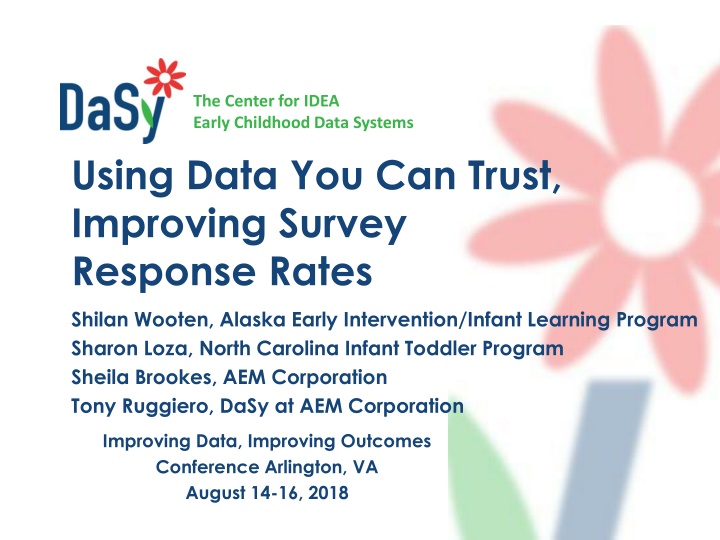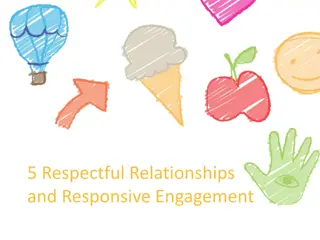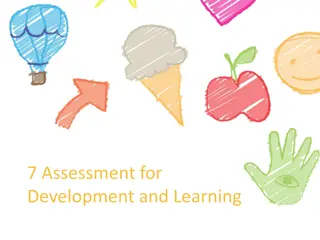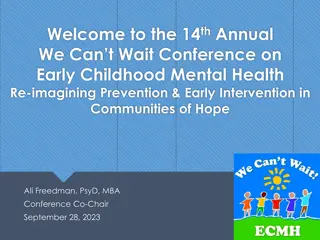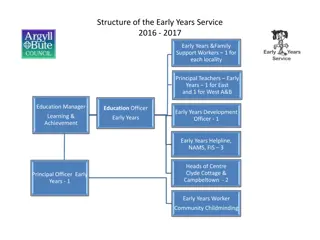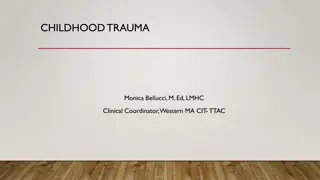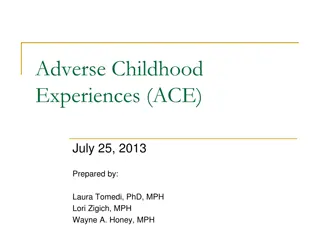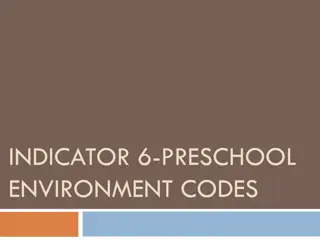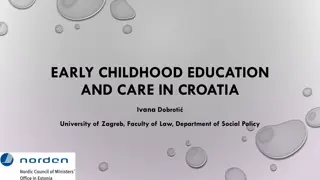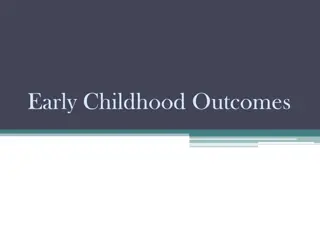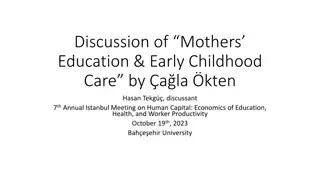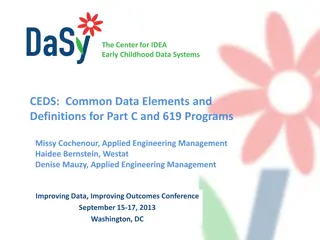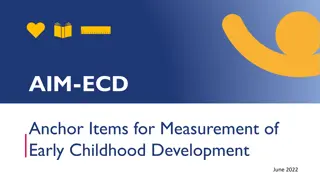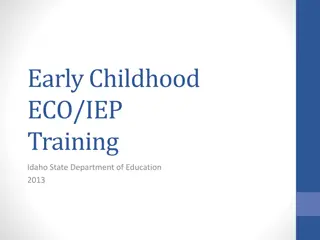Enhancing Family Outcomes in Early Childhood Programs
Explore methodologies and experiences related to improving survey response rates and family outcomes in early childhood programs through discussions on data collection, collaboration with higher education agencies, and survey methodology adjustments. Learn about tools and technical assistance available for optimizing family survey data collection.
Download Presentation

Please find below an Image/Link to download the presentation.
The content on the website is provided AS IS for your information and personal use only. It may not be sold, licensed, or shared on other websites without obtaining consent from the author.If you encounter any issues during the download, it is possible that the publisher has removed the file from their server.
You are allowed to download the files provided on this website for personal or commercial use, subject to the condition that they are used lawfully. All files are the property of their respective owners.
The content on the website is provided AS IS for your information and personal use only. It may not be sold, licensed, or shared on other websites without obtaining consent from the author.
E N D
Presentation Transcript
The Center for IDEA Early Childhood Data Systems Using Data You Can Trust, Improving Survey Response Rates Shilan Wooten, Alaska Early Intervention/Infant Learning Program Sharon Loza, North Carolina Infant Toddler Program Sheila Brookes, AEM Corporation Tony Ruggiero, DaSy at AEM Corporation Improving Data, Improving Outcomes Conference Arlington, VA August 14-16, 2018
Agenda Overview of family outcomes (aka Indicator 4) Advantages and disadvantages of different survey methodologies Survey response rates Considerations for improving response rates Alaska s experience with family survey Group work and discussion Wrap up 2
Concurrent Session Outcomes Participants will learn: How states collect family survey data How Alaska Part C collaborates with a higher education agency to collect family survey data How North Carolina Part C changed their survey methodology to increase response rates About tools and technical assistance related to collecting family survey data 3
Overview of Family Outcomes Performance Indicator States allowed to set performance targets each year Indicator C4 Percent of families participating in Part C who report that early intervention services have helped the family: A. Know their rights B. Effectively communicate their children s needs C. Help their children develop and learn Source: OSEP Part B Measurement Table 4
Overview of Family Outcomes (cont.) All states use survey methodology to report Four main survey approaches are used to collect data NCSEAM Family Survey (18) ECO Family Outcomes Survey, Revised 2011 (17) ECO Family Outcomes Survey, Original (9) State developed surveys (12) Source: ECTA 5
Overview of Family Outcomes (cont.) Survey Type Used by States between FFY14 and FFY15 Survey FFY14 FFY15 NCSEAM Family Survey 20 18 ECO Family Outcomes Survey, Revised 16 17 ECO Family Outcomes Survey, Original 12 9 State developed surveys 8 12 Source: ECTA 6
Overview of Family Outcomes (cont.) Some states tailor their surveys Scoring metrics and indicator thresholds varied among states States must report on representativeness of data and describe improvement strategies Most states report a response rate Response rates range from 9.2% - 100% Source: ECTA 7
Survey Methodology Telephone Mail Face-to-face Internet or web based Mixed Mode 9
Telephone Advantages Less expensive than face-to-face interviews and mail surveys Less time consuming than face-to-face interviews Socially acceptable responses less likely Random digit dialing Train telephone interviewers to stick to the script Develop skip patterns in the computer aided telephone interview (CATI) software 10
Telephone Disadvantages Phone number no longer listed/out of service Cell phones People move and get new numbers Phone number not provided or provided incorrect phone number People can hang up Too many surveys and hard to determine which ones are marketing calls 11
Mail Advantages Respondents can answer in privacy Less expensive than face-to-face interviews Less time consuming than face-to-face interviews Socially acceptable responses less likely 12
Mail Disadvantages People move and do not leave forwarding address People may not open the mail when received Mail not delivered/lost in mail Respondent may not follow skip patterns 13
Face-to-face Advantages Success in avoiding item non-response Respondents more likely to answer open-ended questions Not as sensitive to questionnaire construction as telephone and mail surveys 14
Face-to-face Disadvantages Respondents cannot answer in privacy More expensive than mail surveys More time consuming Socially acceptable responses more likely 15
Internet or Web-based Advantages Good for inclusive groups (employee and customer satisfaction surveys) Survey software has features to develop skip patterns and setting up dates for initial sending and follow up to non-respondents Can reach a very large number of people Cost-effective Access via smartphones 16
Internet or Web-based Disadvantages Not all people have internet access or email addresses Email addresses may not be up to date or not collected People have multiple email addresses Survey representativeness can be an issue 17
Survey Response Rates Low response rates Decrease the statistical power of the data which: Hinders the ability to analyze the data Hampers the ability to generalize results Is indicative of non-response bias within the sample Source: Grand Canyon University Center for Innovation in Research and Teaching 19
Considerations for Improving Response Rates Methodological Considerations Initial contact Reminder Initial dissemination of survey Tickler First follow-up with non-responders Second follow-up with non-responders Additional follow-up Source: Adapted from Dillman 20
The Center for IDEA Early Childhood Data Systems Alaska s Family Outcome Survey
Historical Development Partnership with University of Alaska Anchorage Center for Human Development (UAA CHD) Alaska adopted original ECO Center Family Survey and made modifications: Simplified outcome language Items on one page, comments on back 4-point Likert scale based on feedback from Alaska Native stakeholders
Participant Selection Procedure In February, Alaska Part C Data Manager pulls potentially eligible survey participants for survey target group from Alaska Part C database based on following parameters: Families need to have at least one child eligible for Part C services, enrolled during the previous calendar year, and enrolled for at least six months Randomly select a target group of 158 families from a group of 700+ eligible families
Survey Procedure Provide multiple ways to respond Initial survey packets are mailed to target families in March. Packets contain: an invitational letter, the survey instruments, and a postage-paid return envelope
Survey Procedure Introductory letter invites families to complete survey by mail, online, or using a toll-free phone number Letter informs families that UAA CHD will contact families if survey hasn t been completed
Survey Procedure Invest in return rate: Phone calls to non-responding families Requests to call at another time, opt out, or resend the survey are always honored Reminder post cards
Analyses Summary of responses Comparisons across four regions Comparisons between years Comparisons by race Qualitative data: De-identified positive/mixed/negative comments are included in report
2018 Results Eligible population: 758 families Target group: 152 families Made contact with all 152 families: 69 opted out or did not respond 83 eligible families completed survey Response Rate = 55% 30% completed surveys by mail or online 70% responded by phone
Response Rates by Region Region Sent Received Percentage Northern 34 21 62% Anchorage 62 34 55% Southcentral 24 12 50% Southeast 32 16 50%
Comparison Know their rights Effectively communicate their children's needs Help their children develop and learn 98.61 97.18 96.51 96.2 95.35 95.65 95 94.44 94.2 94.03 94.19 93.1 92.59 92.54 92.54 91.8 91.8 89.86 82.4 78.8 75.3 FFY 2010 FFY 2011 FFY 2012 FFY 2013 FFY 2014 FFY 2015 FFY 2016
Response Rate Over Time Response Rate Over Time 70% 60% 55% 50% 40% 30% 2010 2011 2012 2013 2014 2015 2016 2017 2018
Challenges Inconsistent phone numbers Grouping responses by geographic region Preparing families for the survey Extra childcare items
The Center for IDEA Early Childhood Data Systems North Carolina s Family Outcome Survey
North Carolina Infant-Toddler Program North Carolina Early Intervention Branch located in Division of Public Health (NC DHHS) 16 local Children s Developmental Service Agencies (CDSAs) 100 counties across the state range in enrollment size from approximately 400 to 2600 children Serve approximately 23,000 children per year 34
Historical Development Prior to April 2017, mail paper surveys to all families State Systemic Improvement Plan Initial broad stakeholder engagement Family outcomes survey identified as priority to address low response rates and lack of representativeness Implementation teams formed to address SSIP strands, including family outcomes (Family Engagement Team) 35
Family Engagement Team (FET) Objective provide recommendations for system improvements to enhance family engagement Stakeholders State staff University partners Local representation Parent organization Quarterly meetings (face to face and via webinar) 36
FET Recommendations Adopted new survey - Family Outcomes Survey- Revised) Added comments field to collect qualitative data Change in survey methods Data reporting frequency Family Outcomes Coordinators Evaluation of implementation Strengthening Family Engagement overall in NC ITP 37
Family Outcome Survey-Revised (FOS-R) Part A (24 questions on ways families support child s needs) and B (17 questions on program helpfulness) NC added qualitative comments field Developed by Early Childhood Outcomes Center Ease of administration Less time to complete 38
New Survey Methods Service coordinators inform families of survey Administered at 6- months/semi-annual visit Offered in person with families to be completed via tablet, online, or paper Unique ID Family flyer 39
Family Outcomes Coordinators Identified point person at each CDSA responsibly for quality assurance for FOS Trained FOCs on new survey, methods and implementation Convene quarterly meetings to review data and discuss strategies to improve response rates and data quality 40
Response Rates over Time NC Statewide Response Rate: C4 50% 45% 40% 37% 34% 35% 30% 25% 20% 17% 15% 15% 13% 15% 10% 5% 0% FFY 2012 FFY 2013 FFY 2014 FFY 2015 FFY 2016* FFY 2017** *FFY 2016 includes one quarter only, with a subset of local programs (pilot) **FFY 2017 includes three of four quarters to date, with all local programs included 41
Data Use and Evaluation Local quarterly data reports Evaluation of implementation process to identify successes and improvements Directors use data to positive reinforcements to staff 42
Challenges Response rates not consistently improving and widely variable across the state Ongoing turnover and training Practice of offering survey is still being established Data quality FOUIs, paper submissions missing info, timeliness of completion 43
Next Steps Implement Part A of FOS-R Collectively setting a response rate goal for all CDSAs Improving accountability/monitoring Ongoing training, TA, and evaluation 44
Resources Family Outcomes Data Community of Practice Upcoming meetings September 10 & November 5, 2019 Register: http://ectacenter.org/events/communities.asp#familydata ECTA Family Outcomes online resources: http://ectacenter.org/eco/pages/familyoutcomes.asp Annual APR analysis, Graphing templates, Framework & self- assessment, Representativeness calculator, Family outcomes video, Using data resources Building Stakeholder Knowledge about Data (DaSy) (https://dasycenter.org/building-stakeholder-knowledge-toolkit/ ) DaSy Critical Questions for Analyses (https://dasycenter.org/resources/critical-questions/) 45
Final presentation slide Visit the DaSy website at: http://dasycenter.org/ Like us on Facebook: https://www.facebook.com/dasycenter Follow us on Twitter: @DaSyCenter 46
Thank You The contents of this presentation were developed under a grant from the U.S. Department of Education, # H373Z120002. However, those contents do not necessarily represent the policy of the U.S. Department of Education, and you should not assume endorsement by the Federal Government. Project Officers, Meredith Miceli and Richelle Davis. 47
